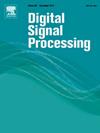基于正交频率分集的合成涡旋波的波束收敛和二维成像
IF 2.9
3区 工程技术
Q2 ENGINEERING, ELECTRICAL & ELECTRONIC
引用次数: 0
摘要
涡旋电磁波携带轨道角动量(OAM)为雷达成像提供了新的可能性,但存在波束空化和能量发散的问题。现有的基于正交波形分集的波束收敛方法需要大量的相位编码符号,抗干扰能力差,计算量大。为了克服这些限制,本文提出了一种基于正交频率分集的合成OAM (OFD-SOAM)雷达系统,该系统通过一种新的频率模式映射策略产生非空心波束,增强了抗干扰能力,同时减少了内存和计算负荷。具体来说,通过联合应用阵元之间的循环相移和频率偏移,建立了一个新的信号模型。设计了一个回波处理框架来精确地重建涡旋相位结构。此外,提出了一种二维OFD-SOAM成像方法,以获得较好的分辨率。仿真结果表明,与传统的oam雷达相比,该系统在鲁棒性和效率方面具有优势。本文章由计算机程序翻译,如有差异,请以英文原文为准。
Beam convergence and 2-D imaging using orthogonal frequency diversity-based synthetic vortex waves
Vortex electromagnetic waves carrying orbital angular momentum (OAM) offer new possibilities for radar imaging but suffer from beam hollowing and energy divergence. Existing beam-converging methods based on orthogonal waveform diversity require numerous phase-coded symbols and lack anti-jamming capability, with high computational overhead. To overcome these limitations, this paper proposes an Orthogonal Frequency Diversity-based Synthetic OAM (OFD-SOAM) radar system that generates non-hollow beams through a novel frequency–mode mapping strategy, enhancing jamming resilience while reducing memory and computational load. Specifically, a new signal model is developed by jointly applying cyclic phase shifts and frequency offsets across the array elements. An echo processing framework is designed to accurately reconstruct the vortex phase structure. Additionally, a two-dimensional OFD-SOAM imaging method is proposed to obtain superior resolution. Simulation results confirm the proposed system's advantages in robustness and efficiency compared to conventional OAM-based radar.
求助全文
通过发布文献求助,成功后即可免费获取论文全文。
去求助
来源期刊

Digital Signal Processing
工程技术-工程:电子与电气
CiteScore
5.30
自引率
17.20%
发文量
435
审稿时长
66 days
期刊介绍:
Digital Signal Processing: A Review Journal is one of the oldest and most established journals in the field of signal processing yet it aims to be the most innovative. The Journal invites top quality research articles at the frontiers of research in all aspects of signal processing. Our objective is to provide a platform for the publication of ground-breaking research in signal processing with both academic and industrial appeal.
The journal has a special emphasis on statistical signal processing methodology such as Bayesian signal processing, and encourages articles on emerging applications of signal processing such as:
• big data• machine learning• internet of things• information security• systems biology and computational biology,• financial time series analysis,• autonomous vehicles,• quantum computing,• neuromorphic engineering,• human-computer interaction and intelligent user interfaces,• environmental signal processing,• geophysical signal processing including seismic signal processing,• chemioinformatics and bioinformatics,• audio, visual and performance arts,• disaster management and prevention,• renewable energy,
 求助内容:
求助内容: 应助结果提醒方式:
应助结果提醒方式:


